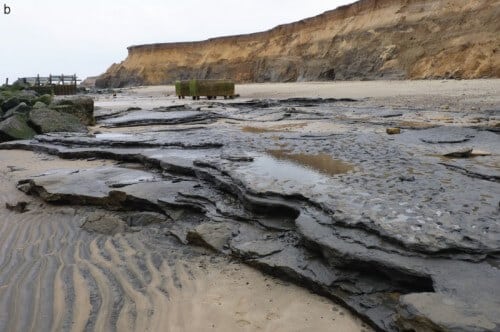A family of five people, including a man whose feet measure 42, crossed the mouth of an ancient river and their footprints were preserved in the mud. At that time, Britain was connected to Europe

The earliest traces of humans outside of Africa were discovered on the shores of England by a team of scientists led by researchers from Queen Mary University of London, the British Museum and the Natural History Museum in London.
Up to five people left a series of footprints in the mud on an ancient river estuary 800 years ago at Happisborough in north-east Norfolk.
Dr. Simon Lewis, from the School of Geography at Queen Mary University, helped put together the pieces of the geological puzzle surrounding the discovery made in May 2013, which is evidence of the first known humans in northern Europe.
Dr. Lewis's study of the geology of the site provided vital information about the sediments in which the footprints were embedded. "My job was to find out the composition and order of the deposits on the site and how they were stratified. This means that I can provide the geological context for the archaeological evidence of human settlement on the site."
The importance of the Hipsboro footprints is that they are unusual in the rarity of surviving footprints at all. Only those in Blatoli in Tanzania are 3.5 million years old and Ilkert and Kobi Pura in Kenya are 1.5 million years older.
Dr. Lewis added that the chances of discovering footprints of this type are rare. They survived environmental changes and the change of times. The timing was also critical "Their location was revealed as soon as the researchers saw it during a geological survey "We knew that weeks later the tides would erode these footprints.
"At first we didn't know what we were seeing," explains Dr. Nick Ashton from the British Museum. "But as we removed the sand and sponges from the sea water, it was clear that the holes resemble footprints and that we must document the surface as quickly as possible.
Over the next two weeks, the researchers used photogrammetry, a technique that can 'stitch' digital images to create a permanent record and XNUMXD visualization of the surface. Analysis of the images confirmed that the elongated holes were indeed ancient human footprints.
In some cases it was possible to identify the heel, the arch of the foot and even the toes of a size 42 foot. It is still not possible to know what the people who left the footprints were doing at the time the analysis hypothesizes that the footprints belong to a mixed group of adults and children.
Their discovery allows a glimpse of prehistoric human migration hundreds of thousands of years ago, at a time when Britain was connected to the European continent. At the same time, deer, bison, mammoths, hippopotamuses and rhinoceros also shared the landscape with the ancient humans. The land provided an abundance of resources for the first humans, edible plant tubers, algae, crabs and oysters nearby, while the grazing herds would have provided meat through hunting or scavenging.
In the last decade, a series of sites where stone tools and fossilized bones were discovered in the same sediments in Hipsboro. The findings were published in the scientific journal PLOS ONE.
The new Hipsborough finds are open to the public in a new exhibition at the Natural History Museum in London: Britain - A Million Years of Human History, which will open on February 13.
For the announcement of the researchers on the Queen Mary University website

9 תגובות
These were Palestinians, I'm sure, so it belongs to them
I saw it, thanks for the link!
This hominid probably hunted mammoths. If you want to bring the mammoth back to life, you need to inject an Asian torch into a gene of fur, a rock rabbit (common ancestor). And if the young of the elephant - mammoth years, they will develop adaptation (adjustment to the environment). And since there were several species and subspecies of mammoth, this has justification - a new species of mammoth.
http://www.telegraph.co.uk/science/science-news/10623660/900000-year-old-footprints-of-earliest-northern-Europeans-discovered.html
This is a Homo erectus species
To the right of the bush to the left
Can anyone see footprints in the photo?
where are they
"Human footprints from 800 thousand years ago" in England?
The oldest remains of the presence of Homo sapiens outside of Africa are 200 thousand years old,
The oldest remains in Europe are less than 60 thousand years old,
What species did the traces belong to?